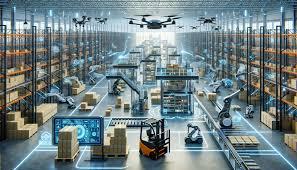Warehouse Automation Market Analysis: Understanding the Role of Automation in Shaping the Future of Logistics and Distribution Networks

Warehouse automation has become an integral part of modern logistics and distribution networks, revolutionizing the way goods are stored, handled, and shipped. As e-commerce continues to expand and customer expectations rise for faster delivery times and efficient services, warehouse automation has evolved from a luxury to a necessity. This article provides an in-depth look at the impact of warehouse automation, its technologies, and the future of logistics and distribution systems.
The Need for Warehouse Automation
The logistics industry is under constant pressure to optimize operations and reduce costs. Traditional manual labor in warehouses can lead to inefficiencies, errors, and delays. As the demand for goods increases, especially with the boom of e-commerce, warehouses are looking for ways to streamline processes and handle higher volumes of orders without sacrificing accuracy or speed. Automation addresses these challenges by improving throughput, minimizing human error, and ensuring that goods are managed more effectively.
Automation also allows warehouses to operate more flexibly, responding to changes in demand and adapting to seasonal fluctuations. By leveraging automated systems, warehouses can maximize storage capacity, reduce labor costs, and improve overall operational efficiency.
Key Technologies in Warehouse Automation
Several technologies are at the forefront of the warehouse automation revolution, each contributing to the efficiency and scalability of logistics operations.
-
Robotics: Robotic systems are commonly used in picking, packing, and sorting. Automated Guided Vehicles (AGVs) and Autonomous Mobile Robots (AMRs) are now deployed in many warehouses to move goods from one location to another. These robots reduce the need for human labor and significantly speed up material handling.
-
Conveyor Systems: Conveyor systems, once a staple in traditional warehouses, are now being enhanced with smart capabilities. These conveyors can integrate with other automated systems, enabling seamless movement of goods throughout the facility.
-
Warehouse Management Systems (WMS): WMS software plays a pivotal role in integrating and managing warehouse operations. This system helps track inventory, streamline order fulfillment, and optimize storage space by using real-time data to make decisions about product placement and retrieval.
-
Artificial Intelligence and Machine Learning: AI and machine learning algorithms enable predictive analytics for demand forecasting and route optimization. These technologies can help automate decision-making processes, allowing warehouses to adjust to shifting market demands and improving resource allocation.
-
Drones: Drones are being explored for inventory management and inspection tasks. They can quickly scan shelves, monitor stock levels, and perform tasks such as checking for damage, reducing the time spent on manual audits.
-
Voice Picking Systems: Voice picking technology uses wearable devices and voice recognition software to guide workers through the picking process. It enhances speed, reduces errors, and increases efficiency by allowing workers to focus on tasks while receiving instructions hands-free.
Benefits of Warehouse Automation
The rise of warehouse automation comes with a variety of benefits for logistics and distribution networks, ranging from cost reduction to improved service quality.
-
Cost Reduction: Automated systems reduce the need for manual labor, lowering labor costs and minimizing the risks associated with human error. Additionally, automated systems are typically more energy-efficient and can reduce overall operational costs.
-
Increased Efficiency: Automated processes reduce the time it takes to pick, pack, and ship products. With automation, goods can be retrieved faster, sorted more accurately, and delivered to customers with fewer delays.
-
Improved Accuracy: With fewer human interactions, the chances of mistakes are drastically reduced. Automated systems ensure that the right products are picked, packed, and shipped, leading to fewer returns and customer complaints.
-
Scalability: Automation systems are highly scalable, meaning warehouses can adjust quickly to increasing demands. With seasonal spikes, such as during holidays or sales events, automated systems can be expanded without a significant increase in workforce size.
The Future of Warehouse Automation
The warehouse automation market is expected to grow significantly in the coming years. With the continuous development of robotics, AI, and IoT (Internet of Things) technologies, the potential for automation in logistics and distribution networks is immense. Automated warehouses are becoming increasingly intelligent, with systems capable of learning from previous tasks and optimizing their performance.
The integration of predictive analytics will also play a vital role in future warehouses. By analyzing vast amounts of data, automated systems will be able to predict demand shifts, plan routes efficiently, and reduce operational costs.
Moreover, the sustainability of warehouse operations will continue to be a key consideration. Automation will help in reducing the environmental footprint of warehouses through energy-efficient systems, waste reduction, and optimized inventory management that minimizes overstocking and waste.
As businesses continue to prioritize speed and efficiency, the role of warehouse automation in shaping the future of logistics and distribution networks will only grow stronger. The transition to fully automated warehouses is not just a trend but a fundamental shift in how supply chains will operate in the future.
Conclusion
The warehouse automation market is transforming the logistics industry by improving efficiency, reducing costs, and enhancing accuracy. As technology continues to evolve, automated systems are becoming more sophisticated and integral to the success of logistics and distribution networks. By embracing automation, companies can stay competitive in an increasingly fast-paced and demanding market, ultimately creating more agile, responsive, and sustainable supply chains.
- Art
- Causes
- Crafts
- Dance
- Drinks
- Film
- Fitness
- Food
- الألعاب
- Gardening
- Health
- الرئيسية
- Literature
- Music
- Networking
- أخرى
- Party
- Religion
- Shopping
- Sports
- Theater
- Wellness


